当前位置:
X-MOL 学术
›
Environ. Sci.: Processes Impacts
›
论文详情
Our official English website, www.x-mol.net, welcomes your feedback! (Note: you will need to create a separate account there.)
Retrospective on microbial transformations of halogenated organics.
Environmental Science: Processes & Impacts ( IF 5.5 ) Pub Date : 2020-02-26 , DOI: 10.1039/c9em00575g P L McCarty 1 , C S Criddle , T M Vogel
Environmental Science: Processes & Impacts ( IF 5.5 ) Pub Date : 2020-02-26 , DOI: 10.1039/c9em00575g P L McCarty 1 , C S Criddle , T M Vogel
Affiliation

|
Prior to the 1960s, knowledge of biological transformations of highly halogenated aliphatic compounds was limited, except in mammalian organisms where enzymatic transformations occurred to rid the body of ingested harmful chemicals. Limited abiotic transformation of such compounds had also been observed, with half-lives varying from days to centuries. Commonly believed was that aerobic transformation might occur by cometabolism rather than to conserve energy for respiration, while anaerobic transformations were in general thought not to occur. However, in the late 1960s anaerobic transformation of chlorinated pesticides was noted, and then in the early 1980s, partial microbial dehalogenation of chlorinated solvents such as tetrachlorethene, trichloroethene, trichlorethane, and carbon tetrachloride was also found to occur. With only partial dechlorination, complete detoxification was not achieved. And at the time, dehalogenation reactions were not believed to yield energy for growth to the degrading microorganisms. However, in the 1990s bacteria began to be found that obtain energy from anaerobic transformations, often enabling complete dechlorination and detoxification. Since then such ability has been found among several bacterial species, many of which use molecular hydrogen as a donor substrate and halogenated organics as electron acceptors, thus conserving energy through reductive dehalogenation. Growth of knowledge in this field has grown rapidly since the 1960s. Broad usages of such microorganisms are now underway to rid contaminated groundwater of hazardous halogenated chemicals.
中文翻译:

回顾卤代有机物的微生物转化。
在1960年代之前,对高度卤化的脂肪族化合物进行生物转化的知识很有限,除了在哺乳动物中发生了酶促转化以消除人体摄入的有害化学物质外。还观察到了这类化合物的有限的非生物转化,其半衰期从几天到几个世纪不等。通常认为有氧转化可能是通过新陈代谢而不是为了节省呼吸能量而发生的,而一般认为无氧转化是不会发生的。但是,在1960年代后期,人们注意到氯化农药的厌氧转化,然后在1980年代初期,还发现了氯化溶剂(如四氯乙烯,三氯乙烯,三氯乙烷和四氯化碳)的部分微生物脱卤作用。仅进行部分脱氯,无法实现完全脱毒。而且在当时,人们不认为脱卤反应会为降解的微生物生长提供能量。但是,在1990年代开始发现细菌可以通过厌氧转化获得能量,通常可以实现完全脱氯和排毒。从那时起,已经在几种细菌中发现了这种能力,其中许多细菌使用分子氢作为施主底物,并使用卤化有机物作为电子受体,因此通过还原脱卤作用来节省能量。自1960年代以来,该领域的知识增长迅速。目前正在广泛使用此类微生物,以清除污染的地下水中的有害卤代化学品。据认为,脱卤反应不产生用于降解微生物生长的能量。但是,在1990年代开始发现细菌可以通过厌氧转化获得能量,通常可以实现完全脱氯和排毒。从那时起,已经在几种细菌中发现了这种能力,其中许多细菌使用分子氢作为施主底物,并使用卤化有机物作为电子受体,因此通过还原脱卤作用来节省能量。自1960年代以来,该领域的知识增长迅速。目前正在广泛使用此类微生物,以清除污染的地下水中的有害卤代化学品。据认为,脱卤反应不产生用于降解微生物生长的能量。但是,在1990年代开始发现细菌可以通过厌氧转化获得能量,通常可以实现完全脱氯和排毒。从那时起,已经在几种细菌中发现了这种能力,其中许多细菌使用分子氢作为施主底物,并使用卤化有机物作为电子受体,因此通过还原脱卤作用来节省能量。自1960年代以来,该领域的知识增长迅速。目前正在广泛使用此类微生物,以清除污染的地下水中的有害卤代化学品。在1990年代开始发现细菌可以通过厌氧转化获得能量,通常可以实现完全脱氯和排毒。从那时起,已经在几种细菌中发现了这种能力,其中许多细菌使用分子氢作为施主底物,并使用卤化有机物作为电子受体,因此通过还原脱卤作用来节省能量。自1960年代以来,该领域的知识增长迅速。目前正在广泛使用此类微生物,以清除污染的地下水中的有害卤代化学品。在1990年代,人们开始发现细菌可以通过厌氧转化获得能量,通常可以实现完全脱氯和排毒。从那时起,已经在几种细菌中发现了这种能力,其中许多细菌使用分子氢作为施主底物,并使用卤化有机物作为电子受体,因此通过还原脱卤作用来节省能量。自1960年代以来,该领域的知识增长迅速。目前正在广泛使用此类微生物,以清除污染的地下水中的有害卤代化学品。因此通过还原性脱卤来节省能量。自1960年代以来,该领域的知识增长迅速。目前正在广泛使用此类微生物,以清除污染的地下水中的有害卤代化学品。因此通过还原性脱卤来节省能量。自1960年代以来,该领域的知识增长迅速。目前正在广泛使用此类微生物,以清除污染的地下水中的有害卤代化学品。
更新日期:2020-02-26
中文翻译:

回顾卤代有机物的微生物转化。
在1960年代之前,对高度卤化的脂肪族化合物进行生物转化的知识很有限,除了在哺乳动物中发生了酶促转化以消除人体摄入的有害化学物质外。还观察到了这类化合物的有限的非生物转化,其半衰期从几天到几个世纪不等。通常认为有氧转化可能是通过新陈代谢而不是为了节省呼吸能量而发生的,而一般认为无氧转化是不会发生的。但是,在1960年代后期,人们注意到氯化农药的厌氧转化,然后在1980年代初期,还发现了氯化溶剂(如四氯乙烯,三氯乙烯,三氯乙烷和四氯化碳)的部分微生物脱卤作用。仅进行部分脱氯,无法实现完全脱毒。而且在当时,人们不认为脱卤反应会为降解的微生物生长提供能量。但是,在1990年代开始发现细菌可以通过厌氧转化获得能量,通常可以实现完全脱氯和排毒。从那时起,已经在几种细菌中发现了这种能力,其中许多细菌使用分子氢作为施主底物,并使用卤化有机物作为电子受体,因此通过还原脱卤作用来节省能量。自1960年代以来,该领域的知识增长迅速。目前正在广泛使用此类微生物,以清除污染的地下水中的有害卤代化学品。据认为,脱卤反应不产生用于降解微生物生长的能量。但是,在1990年代开始发现细菌可以通过厌氧转化获得能量,通常可以实现完全脱氯和排毒。从那时起,已经在几种细菌中发现了这种能力,其中许多细菌使用分子氢作为施主底物,并使用卤化有机物作为电子受体,因此通过还原脱卤作用来节省能量。自1960年代以来,该领域的知识增长迅速。目前正在广泛使用此类微生物,以清除污染的地下水中的有害卤代化学品。据认为,脱卤反应不产生用于降解微生物生长的能量。但是,在1990年代开始发现细菌可以通过厌氧转化获得能量,通常可以实现完全脱氯和排毒。从那时起,已经在几种细菌中发现了这种能力,其中许多细菌使用分子氢作为施主底物,并使用卤化有机物作为电子受体,因此通过还原脱卤作用来节省能量。自1960年代以来,该领域的知识增长迅速。目前正在广泛使用此类微生物,以清除污染的地下水中的有害卤代化学品。在1990年代开始发现细菌可以通过厌氧转化获得能量,通常可以实现完全脱氯和排毒。从那时起,已经在几种细菌中发现了这种能力,其中许多细菌使用分子氢作为施主底物,并使用卤化有机物作为电子受体,因此通过还原脱卤作用来节省能量。自1960年代以来,该领域的知识增长迅速。目前正在广泛使用此类微生物,以清除污染的地下水中的有害卤代化学品。在1990年代,人们开始发现细菌可以通过厌氧转化获得能量,通常可以实现完全脱氯和排毒。从那时起,已经在几种细菌中发现了这种能力,其中许多细菌使用分子氢作为施主底物,并使用卤化有机物作为电子受体,因此通过还原脱卤作用来节省能量。自1960年代以来,该领域的知识增长迅速。目前正在广泛使用此类微生物,以清除污染的地下水中的有害卤代化学品。因此通过还原性脱卤来节省能量。自1960年代以来,该领域的知识增长迅速。目前正在广泛使用此类微生物,以清除污染的地下水中的有害卤代化学品。因此通过还原性脱卤来节省能量。自1960年代以来,该领域的知识增长迅速。目前正在广泛使用此类微生物,以清除污染的地下水中的有害卤代化学品。



























 京公网安备 11010802027423号
京公网安备 11010802027423号